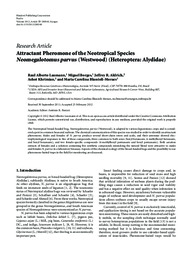Attractant Pheromone of the Neotropical Species Neomegalotomus parvus (Westwood) (Heteroptera: Alydidae).
Attractant Pheromone of the Neotropical Species Neomegalotomus parvus (Westwood) (Heteroptera: Alydidae).
Author(s): LAUMANN, R. A.; BORGES, M.; ALDRICH, J. R.; KHRIMIAN, A.; MORAES, M. C. B.
Summary: The Neotropical broad-headed bug, Neomegalotomus parvus (Westwood), is adapted to various leguminous crops and is considered a pest in common bean and soybean. The chemical communication of this species was studied in order to identify an attractant pheromone. Males and females of N. parvus produce several short-chain esters and acids, and their antennae showed electrophysiological responses to ?ve of these compounds, three common to both sexes (hexyl butanoate, 4-methylhexyl butanoate, and hexyl hexanoate), and two female-speci?c compounds (4-methylhexyl pentanoate and hexyl pentanoate). Both aeration extracts of females and a solution containing ?ve synthetic compounds mimicking the natural blend were attractive to males and females N. parvus in a laboratory bioassay. Aspects of the chemical ecology of the broad-headed bugs and the possibility to use pheromone-baited traps in the ?eld for monitoring are discussed.
Publication year: 2012
Types of publication: Journal article
Keywords: Feromônio, Neotropical broad-headed bug, Praga
Observation
Some of Embrapa's publications are published as ePub files. To read them, use or download one of the following free software options to your computer or mobile device. Android: Google Play Books; IOS: iBooks; Windows and Linux: Calibre.
Access other publications
Access the Agricultural Research Database (BDPA) to consult Embrapa's full library collection and records.
Visit Embrapa Bookstore to purchase books and other publications sold by Embrapa.

